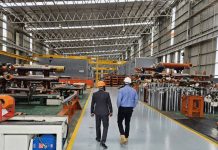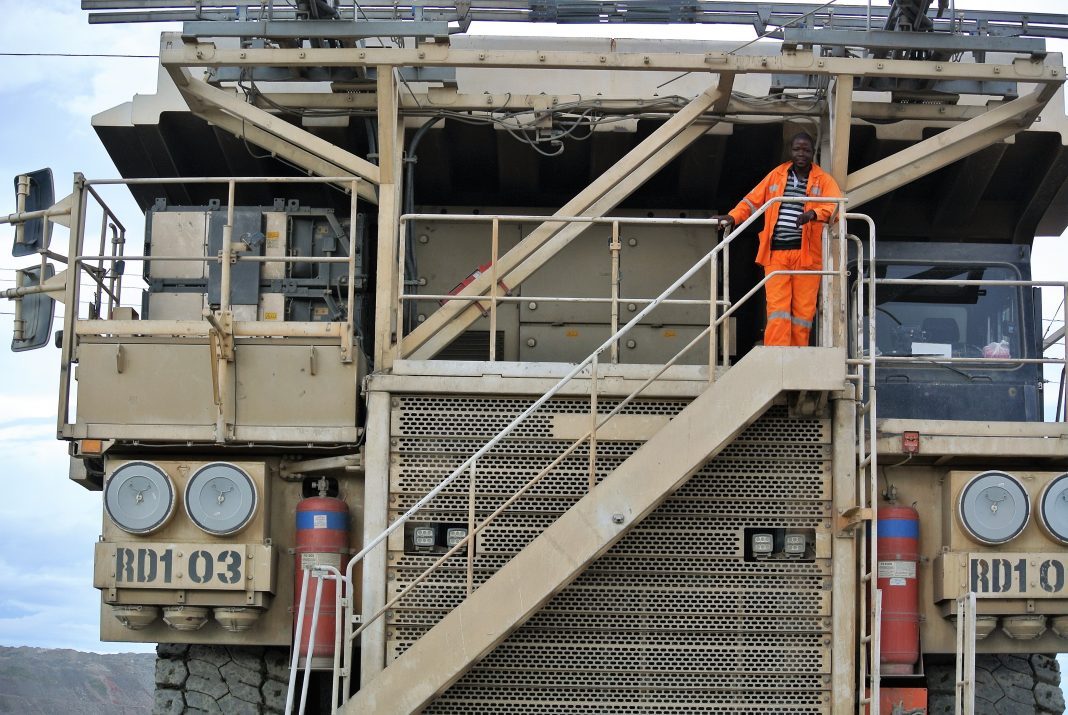It’s not so much a truck as a double-storey building on wheels – you have to climb a full flight of stairs just to get to the balcony that leads to the driver’s cabin.
Once in the driver’s seat, you’re sitting nearly six metres off the ground. At that height, visibility is limited, and pretty much confined to what’s far out in front of you. Almost everything else is in a blind spot.
If an ordinary passenger car were to pass directly in front, on the side or behind, it would be difficult or impossible to see; a collision would be inevitable.
That’s why anyone driving an ordinary passenger vehicle around the pit has to undergo additional driver training to raise their risk-awareness, and must obtain a special driver’s licence. And in order to be more visible to passing truck drivers, their vehicle must carry a 4-metre-high orange flag.
When these measures aren’t followed, the results can be fatal. A few years ago, a Toyota passenger car tragically found itself in the pit, in the wrong place at the wrong time, and without the high-visibility orange flag. It was crushed and flattened under the massive wheels of a passing 180-tonne dump truck after veering into its blind spot. The passenger, an expatriate miner from Asia, was killed instantly. In the interests of safety, the mangled wreck of the vehicle is on permanent display just outside the truck fleet’s parking area, and serves as a grisly reminder of the importance of following correct procedure, and always being alert and aware in the pits.
“The lack of visibility in the driving cabin was a worrying problem for us, especially with the growing number of trucks in the pits as we expanded our operations,” explains Atkins Sitwala, Mining Optimisation Engineer at Kansanshi. “More traffic meant more people – and that meant a greater chance of accidents.”
The solution to the problem was sophisticated camera technology. A screen is located just to the left of the steering wheel. The screen is electronically linked to four cameras situated on all four sides of the truck – front, back and sides. When the driver engages the indicator to turn, the screen automatically shows what’s happening in the direction of turn. Engaging reverse gear shows what is happening behind. When the truck is moving forward in a straight line, the camera’s default setting is the rear view.
“Visibility is not the only problem dump-truck operators have to deal with,” says Atkins. “The other is fatigue. It can result in drivers falling asleep at the wheel.”
Driver fatigue among mine-truck drivers is a well-known global phenomenon. The main reason is the undemanding, repetitive and often monotonous nature of driving heavy vehicles at low speeds around a circuit that doesn’t change very much. Drowsiness is not unusual. Compounding factors are stress, illness and lack of sleep – or poor sleep.
“Our trucks have a sensor that monitors the driver’s eye movements,” says Atkins, pointing at a tiny little device in the middle of the dashboard. “If the truck is in motion and the driver’s eyes close for more than three seconds, an on-board alarm sounds, the seat vibrates and an alert is automatically sent to the control centre.”

The centre then radios the driver to see if he’s okay, or if he needs to take a break. If these “eye-closing” incidents recur, the driver is sent for counselling to find out what might be causing the fatigue.
“It’s not about policing our drivers; rather, it’s about encouraging safety and running the business properly,” says Atkins. “For example, in one case of driver fatigue, it turned out that the driver had just had become the father of newborn twins, and was suffering from lack of sleep.”
These and other fatigue-reducing measures have led to a “dramatic decrease” in the number of incidents of fatigue, and associated accidents, says Atkins.
The challenges of driving big mine trucks notwithstanding, the job remains the most prestigious of driving jobs at any open-pit mine, and many would-be drivers apply for the limited number of positions available. There is no gender bias in recruitment, and truck fleets at Kansanshi – and all other Zambian mines – have many woman drivers.
Filling the tanks requires nearly 3 000 litres of diesel
Finally, the most impressive aspect of the Hitachi EH 3500 – for petrolheads, anyway – is the technical specifications, which make an ordinary passenger vehicle seems like a toy. The truck tyres are more than 3 metres in height. The wheels are driven by a set of electric motors powered by a 16-cylinder, 50-litre diesel engine that cranks out nearly 1 500 kW of power. Filling the tank takes just under 3 000 litres of diesel fuel. Fully loaded, the truck can carry 180 tonnes – that’s 180 000 kg, or the equivalent of more than 2 700 adults.
All of this sophisticated technology doesn’t come cheap: a single truck costs $3.5 million, each of its six tyres costs $65 000, and it takes nearly $3 000 of fuel to fill the tank.
And staggering as those numbers are, dump trucks are not the biggest or the most expensive pieces of mobile machinery in the pits – that honour belongs to the electrically powered rope shovels that fill the trucks. But that’s the subject of another story.
SEE ALSO: Big, clean green machines
























